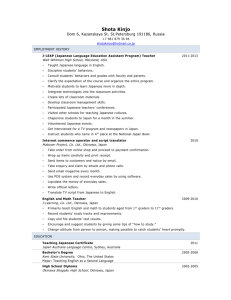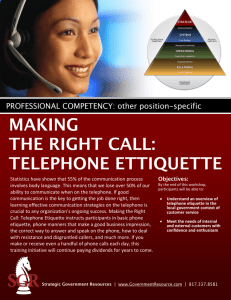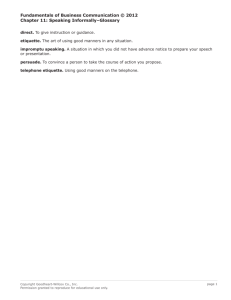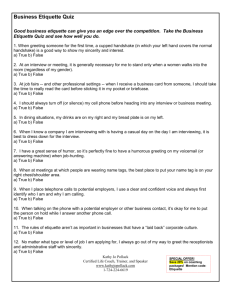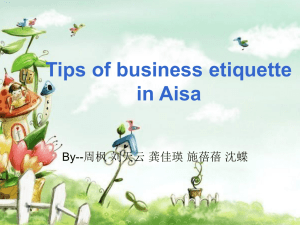OCAT Okinawa - APAN Community
advertisement
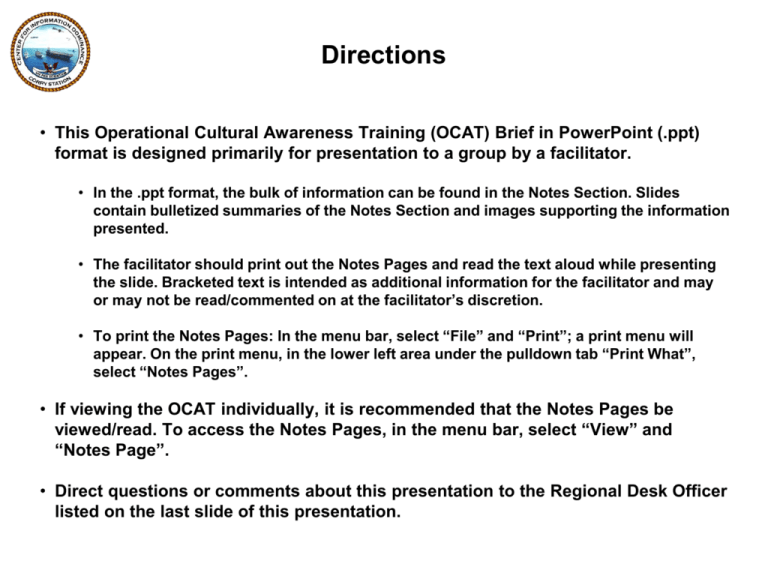
Directions • This Operational Cultural Awareness Training (OCAT) Brief in PowerPoint (.ppt) format is designed primarily for presentation to a group by a facilitator. • In the .ppt format, the bulk of information can be found in the Notes Section. Slides contain bulletized summaries of the Notes Section and images supporting the information presented. • The facilitator should print out the Notes Pages and read the text aloud while presenting the slide. Bracketed text is intended as additional information for the facilitator and may or may not be read/commented on at the facilitator’s discretion. • To print the Notes Pages: In the menu bar, select “File” and “Print”; a print menu will appear. On the print menu, in the lower left area under the pulldown tab “Print What”, select “Notes Pages”. • If viewing the OCAT individually, it is recommended that the Notes Pages be viewed/read. To access the Notes Pages, in the menu bar, select “View” and “Notes Page”. • Direct questions or comments about this presentation to the Regional Desk Officer listed on the last slide of this presentation. Disclaimer This training is an introduction to cultural norms and is NOT intended to countermand or supersede current rules of engagement (RoE). RoE are subject to continuous review and modification in response to strategic objectives and the dynamic tactical environment. Where ambiguity or inconsistency exists regarding what you, as an American service member, should do in a specific situation, consult your chain of command. The photos and text reproduced herein have been extracted solely for research, comment and information reporting, and are intended for fair use by designated personnel in their official duties, including local reproduction for training. A listing of all references and photos used herein is maintained by CLREC. Further dissemination of copyrighted material contained in this document, to include excerpts and graphics, is strictly prohibited under Title 17, U.S. Code. Operational Cultural Awareness Training – Okinawa Prefecture Center for Language, Regional Expertise and Culture (CLREC) A Directorate of the Center for Information Dominance (CID) Pensacola, Florida CLREC@navy.mil Last Update: May 3, 2010 Version 3.0 Introduction The purpose of this brief is to familiarize you with the values, beliefs, behaviors and norms of modern Okinawa; significant cultural differences between America and Okinawa will be presented so that U.S. military operators can understand and anticipate the behavior and thought processes of the Okinawan people. Overview The following characteristics of Okinawa and its people will be presented: • • • • • • • • Geography History Peoples and Ethnic Groups Language Religious Influences Society and Norms Behavior and Etiquette Cultural Summary Prefectural Flag of Okinawa National Flag of Japan Geography • Southern most Japanese prefecture • Part of Ryūkyū Island chain • Okinawa means “sea rope” • Okinawa prefecture • Okinawa Islands • Miyako Islands • Yaeyama Islands • The island of Okinawa • • • • Hiji Falls in Northern Okinawa About ⅓ the size of Rhode Island Includes prefecture capital – Naha Northern ⅔ – mountains, forests Southern ⅓ – rolling hills Naha Geography (Continued) • Subtropical climate • Average temperatures • July – 82°F • January – 61°F • Rainy seasons • May-Jun • Jun-Nov – tropical cyclone • Diverse agriculture and wildlife Nago Pineapple Park Naha Battered by Typhoon Songda in 2004 Geography (Continued) • Dangerous wildlife • Venomous land creatures • Four types of Habu snakes • Brown Recluse spider • Dangerous marine life • • • • • • • • Blue-ringed octopus Box jellyfish Cone shells Lionfish Marine catfish Crown of thorns star Sea snakes Stingrays Lionfish Brown Recluse Spider Sakishima Habu Blue Ringed Octopus Crown of Thorns Starfish History • Inhabited continuously since 2,500 BC • Migration from Melanesia • Migration from Kyūshū (southern Japan) • 779 AD – first written reference to “Okinawa” • A series of dynasties • • • • • Shunten – 1187-1259 Eiso – 1260-1349 Satto – 1350-1405 First Sho – 1406-1469 Second Sho – 1470-1879 Statue of Jianzhen • 1879-1945 – Prefecture of Japan Shuri Castle Shorin-Ryu Karate at Shuri Castle History (Continued) • Ryūkyū Island chain • Important in defense of Japanese mainland • June 1944 – Japanese soldiers sent to Okinawa • Before the battle for Okinawa • October 1944 – Americans commence bombing • March 1945 – American troops land on Kerama Islands • Battle of Okinawa • • • • • 1 April 1945 – invasion begins Lasted 11 weeks 20 June 1945 – battle ended Heavy military casualities ⅓ of civilian population killed Invasion of Okinawa • 2 September 1945 – Japan officially surrendered U.S. Forces on Patrol in Okinawa Japanese Representatives Aboard USS Missouri History (Continued) • 1946 – rebuilding of Okinawa begins • • • • First hospital Civilian newspaper Bank Legal system • By 1950 • Foreign trade begins anew • Civilian government • 1951 – treaty signed with Japan Extensive Damage from the Invasion • U.S. maintained administrative control • Okinawa referred to as residual sovereignty • 15 May 1972 • Full administrative control returned to Japan • Becomes 47th Prefecture of Japan again American Vice President Spiro Agnew Presents Japanese Prime Minister Eisaku Sato With Documents Returning Okinawa and the other Ryūkyū Islands Peoples and Ethnic Groups • Historically descendants of • Japanese • Southeast Asian • Uchinanchu – the people of Okinawa • Do not consider themselves Japanese • Refer to Japanese as Yamatunchus • Culture more influenced by China than Japan • Uchinanchu developed their own • • • • Political system Local and religious festivals Languages Holidays • Similarities to Japanese • Behavior • Social framework • Diet Language • Official language – Japanese • Used during formal occasions • Mainly spoken by younger generation • Taught in school • Uchinaguchi or Uchina Guchi • • • • • Mainly spoken by people over age of 60 Native language of Okinawa Some commonality with Japanese language Used in cultural activities and radio news Grandparents teach younger generation Billboards in Kin, Okinawa – The Center Uses Standard Japanese, the others Use Okinawan • Additional languages in the Ryūkyū Islands • • • • • • • Amami Miyako Kunigami Yaeyama Yonaguni Mutually incomprehensible with others Endangered of being lost Differences in Japanese and Okinawan Numbers Religious Influences • Onarigami – a core belief in Okinawan culture • Sister has spiritual power • Power used to protect her brother • Fire God • Worshipped at kitchen hearth • Predates ancestral worship • Ceramic incense container used to offer prayers • Prayers then offered at ancestral shrine • Prayers always conducted by oldest woman • Prayers conducted on 1st and 15th of each month and during other rituals • Incense container disposed of when the oldest woman dies Kouro Tisaji Hinukan at Nakijin Castle Ruins Religious Influences (Continued) • Many religions practiced • Animism • • • • • Belief in different kinds of spirits Spirits are sacred and supernatural Ceremonies appease the spirits Many rituals throughout year Many sacred places for worship • Shamanism The Sefa Utaki Sacred Site Yutas During the Shioya Ungami Festival • Good and evil spirits • Kaminchu – priestess • Performs all ceremonies in village • Hereditary position • Holds position for life • Yuta – shaman • Intermediary between spiritual and physical world • Called when misfortune present • Highly integrated into society • Sanjinso – fortuneteller • Lunar Calendar • I Ching • Other books Uganju at Ozato Castle Religious Influences (Continued) • Ancestor Worship • • • • Introduced in the 14th century Widespread by the 17th century Ancestors’ spirits watch over descendants Ceremonies honor ancestors • Ancestral shrines in nearly every home • Located in an alcove in a main room • Top shelf includes sacred tables • Oldest woman is in charge of the shrine and conducts rituals Ancestral Shrine • Family tomb • Located in remote areas of a village • Family gathers there for prayers on special occasions Family Tomb Religious Influences (Continued) • Buddhism • • • • Originated in India Mid-6th century – arrived in Japan 7th century – embraced by Empress Suiko Prince Shotoku considered the father of Japanese Buddhism • Buddhist rituals used for almost all funerals • Several large monasteries throughout Japan Tourinji Temple Obon Festival Great Buddha of Kamakura Religious Influences (Continued) • Temple etiquette • Usually must remove shoes • Be calm and respectful • Praying at temples • Throw a coin in the offering box • Pray in front of sacred object • Place incense in burner and wave smoke toward self • Photography • Usually allowed outside • Not usually allowed inside • Signs may be posted Offering Box Conan Praying at Temple Lighting Incense Osenko Remove Shoes Before Entering a Temple Religious Influences (Continued) • Shinto – “way of the gods” • Major influence on culture • Huge shrines throughout Japan • Follow gods or spirits found in nature, heavenly bodies, and natural phenomena • Sacred objects marked with ropes and white paper strips • Temples identified by torii gates • Major differences from other religions • No official creed • No moral guidelines • No holy scriptures Torii Gates Mark Entrance to Torii Station • Shinto, Buddhism, and Christianity combined by many people • Shisa statues outside the house Shisa Statue Shinto Priest Religious Influences (Continued) • Shrine etiquette • Calm and respectful • Do not visit while sick, with and open wound, or while mourning • Before entering • Rinse hands at purification fountain • Rinse mouth • Prayer • • • • • • Throw a coin in the offering box Bow deeply twice Clap hands twice Bow deeply once Prayer for a few seconds Strike gong before praying if present Praying at a Shrine • Photography usually allowed – look for signs Purification Fountain Religious Influences (Continued) • Confucianism – a philosophy • Based on The Analects • Important impact on Japanese culture • Some core teachings • • • • • • • Social harmony Parental respect Loyalty to superiors Kind and bureaucratic government Family loyalty Ancestor worship Respect for the elderly Statue of Confucius • Other areas of importance • Prominent in Japanese development of education system • Credited with writing the original Golden Rule Honoring Ancestors Religious Influences (Continued) • Taoism • Both philosophy and religion • Developed over 2,500 years ago • Taoism influences • Japanese thought • Zen Buddhism • Shamanist tradition and rituals • Other beliefs rooted in Taoism • • • • Rinzai Buddhist Sect Temple Lunar calendar Selection of favorable days Selection of building sites Folk medicine • Yin and Yang – symbolizes perfect balance • Black – yin • White – yang • Does not represent good and evil Yin and Yang Society and Norms Family and Family Values • Marriage • • • • Bride of eldest son moves to in-laws’ home Adds to social interaction Married couple helps financially Inherit family altar • Onarigami • Can cause conflict with married brothers • Proverbs and fables – wives have negative influence, sisters protect • Girls stay attached to their “birth” home • Visit often, sometimes daily • Can cause conflict with in-laws An Okinawan Women Tends to a Family Tomb Society and Norms (Continued) Gender Roles • Role of women in mainland Japan • Responsible for the home • Men responsible for income • Role of women in Okinawa • Well-regarded • Responsible for religious activities • Believed to have ability to communicate with gods Women in Traditional Clothing at Shuri Castle Women Praying at Utaki Conducting Prayers to the Fire God Women Praying in Animist Ceremony Society and Norms (Continued) Dress and Appearance • Typical clothing • Reflects tropical climate • Mostly Western-styles • Traditional clothing • • • • Hand woven Dyed using natural colors Geometric designs vary Kariyushi – very common • Bingata-styled Women Selling Fresh Produce Typical Everyday Clothing • Dyed cloth • Used for ceremonies • Designs inspired by nature Bingata-styled Dance Clothing Japan’s Prime Minister and Cabinet Members Hold a Meeting Wearing Okinawan Kariyushi Shirts Society and Norms (Continued) Housing • Mainland Japan • Houses built with wood • Open floor plan • Okinawa • • • • Houses built with concrete Barred windows Built to withstand typhoons 3 basic types of structures • Roofing – Chinese influenced • Usually red in color • Build to withstand high winds Apartment Building Near Kadena Airbase • Shisa found on most single-family homes Shisa Family Housing on Kadena Airbase Society and Norms (Continued) Literacy and Education • Literacy – 99% male and female • Primary education • Mandatory for ages 6-15 • Generally free • Curriculum stresses math and sciences • Private schools • Require difficult entrance exams • Students attend cram schools to prepare • University • Required difficult entrance exams • Competition intense • Affiliated with elementary, middle, and high schools Iheya Junior High School Students from Iha Elementary School Present U.S. Marines with Gifts as a Sign of Appreciation Society and Norms (Continued) Medicinal and Healing Practices • High standard of health • Low infant mortality • Extremely long life expectancy • Healthy diets and active lifestyle • Medical facilities are very good • Universal health care • Everyone falls into 1 of 2 programs • Costs based on earnings Hospital in Kochinda Society and Norms (Continued) Crime, Vice and Trafficking in Persons • Level of crime – low • • • • • • • Personal disputes Theft Vandalism Violent crime rare Sexual assaults Hate-crimes possible Pick-pocketing in crowded places Japanese Police Bar • Organized crime – Yakuza • • • • Sex-related industry Gambling Protection racket Bars and nightclubs • Travel advice • Travel in pairs • Do not carry large sums of money • Keep wallet in front pocket Nightclub A Message Written on the Roof of a Ginowan City Building Society and Norms (Continued) Crime, Vice and Trafficking in Persons (Continued) • IAW UCMJ U.S. armed forces and DoD civilians prohibited from engaging in any form of prostitution • Trafficking in persons – major problem • Women are trafficked • • • • From other Asian countries Brought into country Japan on entertainment visas Passports seized by managers Work to pay off debt • Employed in bars • Located in major metropolitan areas • Near military installations • Base commanders typically publish off-limits areas U.S. Department of Health and Human Services Graphic Society and Norms (Continued) Recreation • Popular sports: • • • • • • • • • Popular activities: Soccer Basketball Baseball Softball Martial arts Water sports Volleyball Track and field • • • • • • • • • Television Karaoke Movies Bars and nightclubs Nature walks Diving Botanical gardens Expo Park American Village Southeast Botanical Garden American Village Expo Park Society and Norms (Continued) Arts • Dance • Eisa – the most well-known • Main performance at end of Obon festival • Music • Sanshin – three-stringed lute • Taiko drums – large • Paranki drums – small Eisa Dance • Karate – from Okinawa • Lacquer ware Paranku Sanshin Karate Taiko Society and Norms (Continued) Holidays • Important holidays • • • • • • • • • • • New Year’s Day Adult’s Day National Foundation Day Vernal Equinox Day Golden Week Holidays Marine Day Respect for the Aged Day Autumnal Equinox Day Culture Day Labor Thanksgiving Day Emperor’s Birthday 1 January Second Monday in January 11 February First day of spring 29 April, 3-5 May Third Monday in July Third Monday in September First day of fall 3 November 23 November 23 December Vernal Equinox • Many important festivals and religious rituals Dragon Boat Races Kick Off Golden Week Standing on the Rope, Preparing for the Tug-of-War Behavior and Etiquette Introductions, Meeting and Greeting • Proper etiquette is very important • Greetings • Bowing most common • May shake hands with non-Japanese • Handshakes slightly different than in U.S. • Bowing – a sign of respect • • • • • • • Different bows for different reasons Originate at the waist Back straight Hands at sides for men and boys Hands in lap for women and girls Depth of bow depends on relationship Longer, deeper bow shows more respect Behavior and Etiquette Introductions, Meeting and Greeting (Continued) • Introductions • Wait to be introduced • Considered rude to introduce oneself • When introducing someone else • Do not point with the index finger • Point with an open hand Correct Note the open hand Incorrect Never use the index finger to point Behavior and Etiquette Introductions, Meeting and Greeting (Continued) • Seating arrangement • • • • Most important guest furthest from entrance Guests in front of niche or alcove Least important person by the entrance Highest ranking person behind the driver • Speeches • Highest ranking person speaks last • Higher status person speaks politely using casual speech • Lower status people use “super polite” or “respectful” language Behavior and Etiquette (Continued) Non-Verbal Communications • American gestures • May have no meaning in Japan • Could be misinterpreted • Acceptable gestures • Sniffing • Snorting • Spitting • Unacceptable gestures • • • • • • Blowing nose in public Keeping hands in pockets while speaking Pointing with index finger Prolonged direct eye contact Dramatic arm and hand gestures Unusual facial expressions Avoid Blowing Nose in Public Smile, Even When Angry Behavior and Etiquette (Continued) Non-Verbal Communications (Continued) • Laughter – meaning depends on context • • • • Embarrassment Confusion Shock Amusement • Personal space • Larger than in the U.S. • Men do not slap each other on the back • People may push others out of their way • More behaviors to avoid • • • • Standing with the legs crossed Leaning on walls or desks Crossing ankle over leg Showing the bottom of the feet Behavior and Etiquette (Continued) Non-Verbal Communications (Continued) • Come here • Hand held palm down and fingers flapped • Should not be used with superiors • No • Open hand waved in front of face • Faster wave is more emphatic • Has multiple meanings • Excuse me • In a crowd or as an apology • Hand flat in front of nose Are You Talking to Me? Excuse Me • Let’s eat • Middle and index finger simulate chopsticks • Pretend to shovel food from the other hand • Me • Index finger to nose • Has multiple meanings Come Here Let’s Eat Indicates No Behavior and Etiquette (Continued) Non-Verbal Communications (Continued) • Sitting upright on the floor very common • During meals • Tea ceremony • Other traditional events • Formal way of sitting – seize style • May be uncomfortable • Foreigners may not be expected to do so • Casual sitting • Men – legs crossed in front • Women – on knees with legs to one side Formal Style For Men • Shoes • Removed before entering many places • Socks should be clean and in good repair Informal Style for Men Only Sitting in the Formal Seize Style Informal Style for Women Only Behavior and Etiquette (Continued) Official Business and Meetings • Meetings • Punctuality important • Japanese may be late • Saving face • • • • Very important in Japan Never embarrass or criticize in public Do not force person to admit lack of knowledge Ask if further information is desired • Silence while communicating • • • • • Could indicate a lack of knowledge on a topic Considered useful and valued May be reflecting on the conversation Do not break the silence May be used to personal advantage Be on Time Silence is Golden Behavior and Etiquette (Continued) Official and Business Meetings (Continued) • Form of address • Introduction may be the last name only • Attach the suffix -san as a sign of respect • Business cards • • • • • • • Presented and accepted with both hands Treated respectfully Presented with introduction – organization, position, and name Held by corners, face up, facing recipient Reviewed when received, followed by a bow Placed in shirt pocket or held Bilingual business cards are a very good idea • Gift giving • Gifts common, especially at first meeting, mid-year, and New Year’s • Wrapped and unwrapped very carefully • Sweets, tea, coffee, liquor, sporting goods Behavior and Etiquette (Continued) Social Engagements and Visiting • Shoes and slippers • • • • Shoes not worn in homes If wearing sandals, carry white socks Slippers provided for guests at the door Slippers not worn in bathroom or on tatami mats • Bathing • Baths are for relaxation, not cleaning • Body and hair cleaned before entering the tub • Separate sink or faucet and stool near tub Tatami Mats in a Japanese Home Slippers Kept by the Door Shoes Left at the Door Japanese Bathroom Behavior and Etiquette (Continued) Food and Dining • Wipe hands with damp towel provided • Chopsticks – hashi • Primary eating utensil • Honest attempt to use shows respect for the culture How to Properly Hold Chopsticks • Proper chopstick etiquette • Place across bowl when not in use • Place in rest if provide, on bowl, or in paper sleeve when finished • Improper chopstick use • • • • • • Left sticking out of a bowl Transferring food to someone else’s Moving a bowl In a communal bowl Waived over bowls Spearing food Improper Correct Chopstick Placement Behavior and Etiquette (Continued) Food and Dining (Continued) • Table manners • All foods placed before eating • Itadakimasu – before the meal • Gochisosama deshita – after the meal • Soup • • • • • Drunk directly from the bowl Solid portions taken with chopsticks Slurping accepted and expected Noodles led into mouth with chopsticks Eaten with ceramic spoon if provided Chimushinji – Typical Soup Proper Way to Eat Rice • Rest of the meal • • • • Bite of main food, a bit of rice, some soup Large pieces separated with chopsticks or bitten Small portion of rice saved for the end Dishes returned to positions at end of meal Itadakimasu – Said Before a Meal Soba in Okinawa Behavior and Etiquette (Continued) Food and Dining (Continued) • Drinking etiquette • • • • People serve each other Refill friend’s cups when near empty Allow friend to refill your cup Place hand over cup if no more desired • Toasting etiquette • Wait until all glasses have been filled • Everyone should stand before the toast • Kampai – to your health • Drinking too much • Inappropriate in very formal restaurants • Acceptable in less formal restaurants if one does not bother others Saki Behavior and Etiquette (Continued) Food and Dining (Continued) • Typical foods • Strong flavors • Spicy • Chinese-influenced • Staple foods • • • • • • Pork – the entire pig Seafood Vegetables Fruits Black sugar Awamori – rice liquor Awamori Chanpuru • Popular foods • • • • Chanpuru – stir fry Rafuti Toofuyoo – snack Taco rice Rafuti Taco Rice Cultural Summary • 47th Prefecture of Japan, includes 3 major island groups • Okinawa is the largest and most populated island • Subtropical climate similar to Hawaii • Populated continuously for 4,500 years, played a major role in World War II • Okinawans are descendents of Japanese and other southeast Asian peoples • Official language is Japanese, Uchina Guchi spoken by older people • Very diverse mix of indigenous and imported religions • Normally wear Western styles, traditional clothes for their numerous festivals • Extremely long life expectancy due to diet and lifestyle • Women play a key role in religion, concept of Onarigami very important to the culture • Proper etiquette extremely important to building relationships • Observing etiquette builds trust and demonstrates appreciation of Okinawa culture CLREC Contact CLREC@navy.mil COMM: 850.452.6736 DSN: 922.6736
